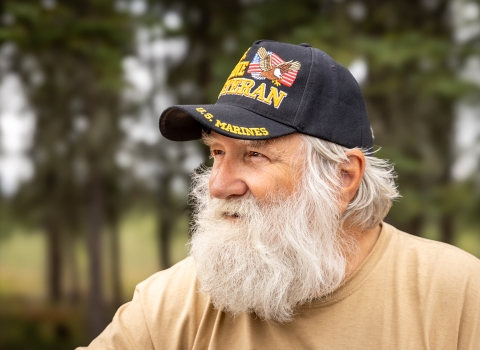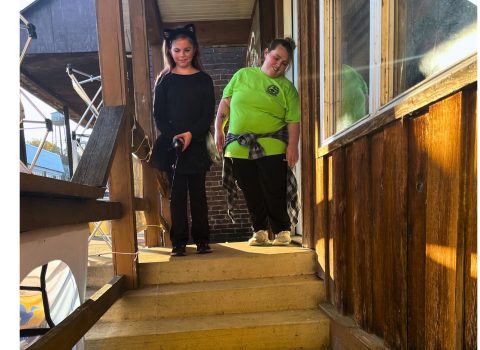El Yunque National Forest, Puerto Rico – They’re old, parenthood behind them, but that hardly means the two senior citizens serve no purpose.
They like to talk. Others, sometimes, show up to listen.
People here call them Egida, literally, a “house for the elderly.” The Spanish-to-English translation describing their function is not precise, but it’s close enough. The Puerto Rican parrots sit in a cage and call to their wild peers. It’s one way scientists assess how well the endangered species survived Hurricane Maria.
The couple is among about 240 birds that weathered the tempest when it struck Puerto Rico late last month. Most of them stayed in a reinforced-concrete building at an aviary owned and operated by the U.S. Fish and Wildlife Service (Service).
While 150 mph winds ripped the jungle apart, two Service workers, Thomas White and Arelis Johnson, remained at the aviary to await the storm’s passage. With them were parrots in cages, brought inside before hell came howling.
The birds did well. None died during the storm, though nine succumbed to heat and stress afterward.
For that, Jafet Velez is grateful – pleasantly surprised, too.
“I was amazed,” said Velez, a Service biologist with nearly 30 years experience working with the parrots. “I thought they would have been more stressed.”
Maybe the birds knew they were in the right hands. Service biologists have been working for decades to propagate a species that perched on the edge of extinction 50 years ago.
The three sites that support Puerto Rican parrots: (1) El Yunque National Forest, (2) Rio Abajo Commonwealth Forest, (3) Maricao Commonwealth Forest.
Though the bird is still endangered under the Endangered Species Act, it shows small signs of recovery with each clutch of chicks.
Still, Maria – and, before it, Hurricane Irma – tested the species as it hadn’t been tested in years.
Tested Service workers, too. The aviary here has been without power from the grid since the hurricane made landfall Sept. 20; a generator powers a refrigerator and freezer that keep bird food and other essentials chilled. Cell phones cannot find a signal. The only cool air comes from breezes off fog-shrouded peaks.
No one is sure when the aviary will be fully functional again.
No regrets
He began working for the Service as a young man wanting to set aside cash to pay for medical school. But something about the birds called to him. Velez, now 49, delayed med school for a year, then another, then a third.
“And now, it’s 28 years later!” he said. “I don’t regret it!”
He may be Puerto Rico’s No. 1 parrot cheerleader. Velez sometimes wanders among the cages, thinking: Is that bird ready for mating? Should I change this one’s diet? Other times he’s a torrent of facts – that parrots can live to be 40; that they’re territorial; that they mate for life.
Well, not always for life. One couple recently had “marital difficulties,” Velez said. “I separated them for counseling,”
That doesn’t always work. He takes some feuding birds to a community cage where parrots get acquainted with others. Velez calls it the “love shack.”
That shack must be working. Breeding operations have grown from one chick, born in 1979, to more than 100 hatched last year. They were born here and at three other aviaries in Puerto Rico. The Service is a partner with Puerto Rico’s Department of Natural and Environmental Resources in helping the species recover.
It’s a small step in a long journey to replenish a species that once numbered 1 million. That was 500 years ago, before humans began carving Puerto Rico’s fertile hillsides and valleys into plantations, ruining the parrots’ habitat.
In 1975, biologists counted 13 Puerto Rican parrots in the wild. “It was probably the most endangered bird in the world,” Velez said
Now? “We are confident we will have an awesome 2018 breeding season.”
‘Like magic’
Caa-caa-caaa! The cry echoed from “condo” cages erected side-by-side to large mesh enclosures where scores of birds rested on perches, occasionally flying from one end of the Quonset-hut-style cages to the other, a 60-foot jaunt.
Velez didn’t flinch. He’d heard it before. The loud bird, he said, was acting as a lookout. If something unusual were to appear – a snake, perhaps, or an unfamiliar human tromping all about – Caa! The bird would alerts its peers. It’s how they’ve survived.
They’ve also made it from year to year with some critical human help. The aviary here has a hospital, with medicine and enclosures for ailing birds. On a recent day, a veterinarian visited the aviary and fixed a broken wing, then stitched an injury.
The Service also is repairing other enclosures to give the birds extra room. Falling trees rendered them uninhabitable. Even now, some are branded with ribbons whose warning is hard to ignore: KILLER TREE.
Yes, it’s a lot of work, said Velez, but the parrot deserves it. The species was fine, he said, until another animal began taking its habitat.
Now, he said, that species – Homo sapiens – owes it to Amazona vittata to give the parrots a chance to survive.
It’s a matter of national pride. Along with the coqui, the tiny frog that peeps every night, the parrot is one of the territory’s signature animals. “You see it painted on walls … everywhere around here.”
On a more basic level: The parrot has a right to this world, too.
Velez knows. He remembers visiting El Yunque years ago. He was 16, unfamiliar with the forested folds of the rain forest.
He took it all in – the shadows, the mist, the feeling that he stood in a special place where something rare flitted in the green heights. “It was like magic, like wow!” he said. “It was like the answer to a prayer.”
So plans for a medical career made way for a life saving birds. For what it’s worth: His daughter is attending med school.
And the Egida, those two old parrots?
Perhaps they’re talking about that.


